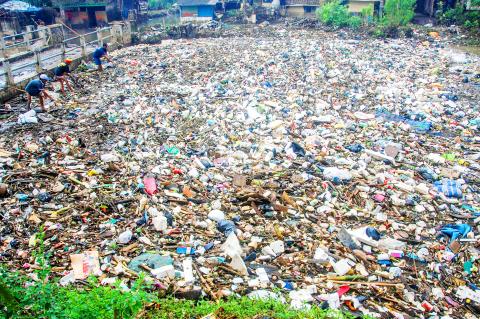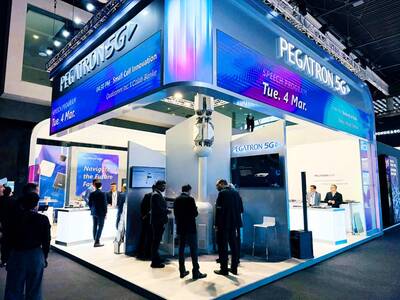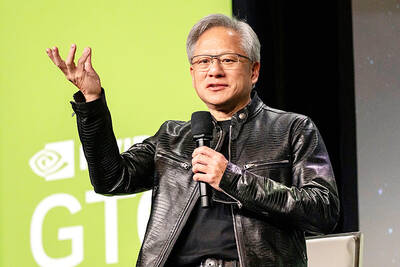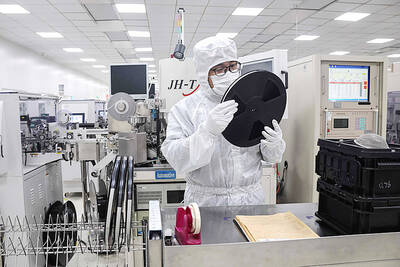The scabies on Indonesian rice farmer Yusuf Supriyadi’s limbs are a daily reminder of the costs of living next to the “world’s dirtiest river.”
Supriyadi depends on the Citarum River’s murky waters — a floating carpet of household garbage, toxic chemicals and animal feces — to irrigate a small rice plot in West Java Province that sustains his family of six.
The farmer’s rice yield is now down by two-thirds in the rainy season as textile factories dump increasing amounts of industrial waste into the river, but he has few other options.

Photo: AFP
“There are floods during the rainy season. My hands get itchy and the harvest is damaged,” the 54-year-old told Agence France-Presse. “Pollution makes my rice hollow. If I keep going I’ll lose money, but if I don’t, I’ll have no other job.”
Now faced with a health emergency after decades of failed cleanup efforts, Jakarta is stepping in with a seemingly impossible goal: make the Citarum’s water drinkable by 2025.
Using this polluted water is a risky calculation for many of the 30 million people who rely on it for irrigation, washing and even drinking water — including about 80 percent of residents in the sprawling capital, Jakarta.
At nearly 300km long, the river is also a key source for hydroelectric power for Indonesia’s most populated island, Java, and tourism hot spot Bali.
The World Bank declared it the most polluted river in the world a decade ago, a description widely picked up by media and environmentalists.
Waste levels can vary depending on how pollution is measured and the time of the year, but the Citarum is dangerous by almost any standard.
Previous research has shown it has alarming levels of toxic chemicals — including 1,000 times more lead than the US standard for safe drinking water.
It regularly appears on most polluted lists alongside India’s Ganges River, the US’ Mississippi River and China’s Yellow River.
In January, Jakarta yanked responsibility away from local governments and vowed to get tough on business owners who ignore waste disposal rules. Factories that fall short could have operating permits revoked.
CCTV cameras are to be installed along the river’s banks to keep an eye out for offenders dumping waste in the early morning hours to evade detection.
Meanwhile, dredging equipment is to be used to clean up the filthy river, Indonesian Ministry of Maritime Affairs and Fisheries spokesman Djoko Hartoyo said.
“We are not playing around this time,” he said. “We’re going in with a holistic approach, so we are optimistic we can make Citarum clean again, just like it was 50 or 60 years ago.”
In the 1980s, a new industrial zone sprang up around the small town of Majalaya, about 170km east of Jakarta, and things quickly changed for the pristine river.
About 2,000 textile factories in the area have provided much-needed jobs, but they came with a heavy cost: About 280 tonnes of industrial waste are dumped into the river each day, government and environmental group data showed.
Making matters worse, many locals think nothing of tossing their household waste into its toxic waters.
“When it rains and my house gets flooded, the smell is awful,” Achmad Fachrureza said from inside an inflatable dingy as he navigated the river’s polystyrene foam containers, fabric, empty cans, plastic bottles and garbage bags.
The 57-year-old villager said he was fired from his job as a textile factory security guard after asking questions about the firm’s waste disposal system.
Factory pipes dump waste directly into waters bubbling with chemical dyes used in textiles, creating an overwhelming stench.
“Most factories here have a waste disposal system, but they don’t work properly, because it’s just a formality,” said Deni Riswandani of Elingan, a local environmental group.
That poses a serious health risk, especially for the 5 million people living in the river’s basin. Many locals suffer from skin diseases such as scabies and dermatitis, as well as respiratory infections from inhaling factory pollution.
“The number of people going to the health clinic is very high,” Riswandani said. “We keep reporting these issues to the government, but we never get a solution.”
He and other frustrated activists have blocked some waste pipes with rocks and concrete, but the factories usually remove the blockage right away.
Locals hope Jakarta’s new goals can be achieved, but they are also skeptical given the scale of the task and endemic corruption that could see factory owners try to buy their way out of trouble.
“I long to see the Citarum like it was when I was young,” Fachrureza said. “I could swim in it and drink the water. It was so clean.”

‘DECENT RESULTS’: The company said it is confident thanks to an improving world economy and uptakes in new wireless and AI technologies, despite US uncertainty Pegatron Corp (和碩) yesterday said it plans to build a new server manufacturing factory in the US this year to address US President Donald Trump’s new tariff policy. That would be the second server production base for Pegatron in addition to the existing facilities in Taoyuan, the iPhone assembler said. Servers are one of the new businesses Pegatron has explored in recent years to develop a more balanced product lineup. “We aim to provide our services from a location in the vicinity of our customers,” Pegatron president and chief executive officer Gary Cheng (鄭光治) told an online earnings conference yesterday. “We

It was late morning and steam was rising from water tanks atop the colorful, but opaque-windowed, “soapland” sex parlors in a historic Tokyo red-light district. Walking through the narrow streets, camera in hand, was Beniko — a former sex worker who is trying to capture the spirit of the area once known as Yoshiwara through photography. “People often talk about this neighborhood having a ‘bad history,’” said Beniko, who goes by her nickname. “But the truth is that through the years people have lived here, made a life here, sometimes struggled to survive. I want to share that reality.” In its mid-17th to

‘MAKE OR BREAK’: Nvidia shares remain down more than 9 percent, but investors are hoping CEO Jensen Huang’s speech can stave off fears that the sales boom is peaking Shares in Nvidia Corp’s Taiwanese suppliers mostly closed higher yesterday on hopes that the US artificial intelligence (AI) chip designer would showcase next-generation technologies at its annual AI conference slated to open later in the day. The GPU Technology Conference (GTC) in California is to feature developers, engineers, researchers, inventors and information technology professionals, and would focus on AI, computer graphics, data science, machine learning and autonomous machines. The event comes at a make-or-break moment for the firm, as it heads into the next few quarters, with Nvidia CEO Jensen Huang’s (黃仁勳) keynote speech today seen as having the ability to

The battle for artificial intelligence supremacy hinges on microchips, but the semiconductor sector that produces them has a dirty secret: It is a major source of chemicals linked to cancer and other health problems. Global chip sales surged more than 19 percent to about US$628 billion last year, according to the Semiconductor Industry Association, which forecasts double-digit growth again this year. That is adding urgency to reducing the effects of “forever chemicals” — which are also used to make firefighting foam, nonstick pans, raincoats and other everyday items — as are regulators in the US and Europe who are beginning to